
Phlox paniculata 'Satin Veil'
Pinkish purple form of paniculata, old fashioned colour good with David Austin roses. Best grown in a herbaceous border or cottage garden setting.


Tall, decorative late summer flowering purple biennial, introduced to us by Karen Hall. Treat like Angelica gigas, often takes three years to flower then self seeds.
Tall, decorative late summer flowering purple biennial, introduced to us by Karen Hall. Treat like Angelica gigas, often takes three years to flower then self seeds.
Data sheet
Pinkish purple form of paniculata, old fashioned colour good with David Austin roses. Best grown in a herbaceous border or cottage garden setting.
Pink Siberian iris which combines well with white colour schemes. Useful for in-fill between roses or in the mixed border.
Rich red flowers that eventually fade to brick red, perfect with old fashioned roses and warm colours in the cottage garden or herbaceous border.
A lovely geranium for a partly sheltered cottage garden setting, producing lavender soft pink flowers forming an attractive clump. Best in good soil with some protection from wind, ideal between roses.
Very pale turkish delight pink with no spots, never many spare of these but occasionally a few divisions available in winter through to spring.
This variety is particularly good in autumn when the seedheads elongate and stand above the foliage. Another tall variety for behind the border, best cut down to ground level every few years.
Perennial wallflower that begins purple and transforms to apricot peachy tones as the flowers age, giving a lovely effect. Winter flowering, bird and butterfly attracting, fragrant.
Pink form of Salvia nemorosa, best suited to bedding and mass plantings for bold colour effect during summer.
The usual form is silver but this variety has purple tinted leaves. Great in a large pot or tub, alternatively in the rock garden or border. Prefers well drained soil.
Wonderful evergreen shrub from New Zealand with ornamental leathery leaves and white daisy flowers. Requires a dryish well-drained site or a large pot.
Cushion-forming plant from Chile for the rockgarden or trough. Great around stones, spreads horizontally to form a tight mat.
Bold foliage plant for moist areas with exotic foliage, native to Myanmar and Tibet. Extremely cold hardy, best grown along with other moisture loving plants on a pond margin or in part shade woodland environment. Associates well with filipendulas, astilbes, gunneras and primulas.
Hand pollinated seedlings from our best dark flowered plants from imported stock.
Large salmon-pink flowers with blackish-purple spotting. A vigorous free flowering variety which complements roses and paeonies.
Shade loving plant with interesting mottled foliage and pink spotted flowers. Multiplies easily in part shade on moist leafy soil, associates well with hostas and epimediums.

Tall, decorative late summer flowering purple biennial, introduced to us by Karen Hall. Treat like Angelica gigas, often takes three years to flower then self seeds.